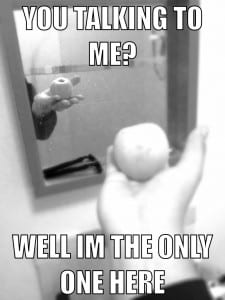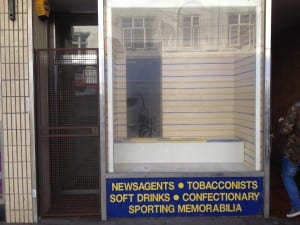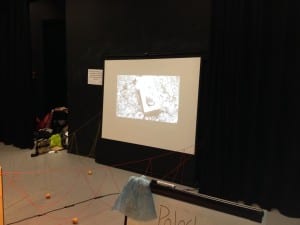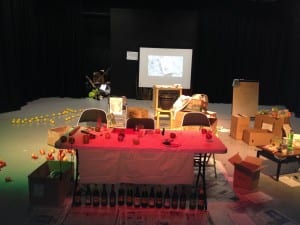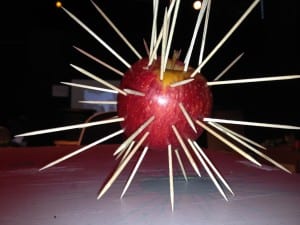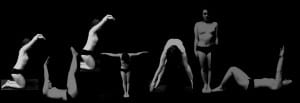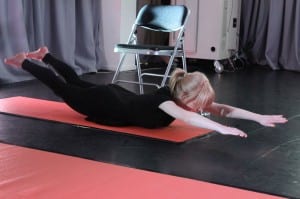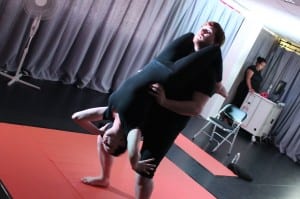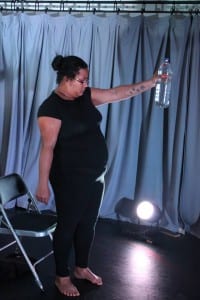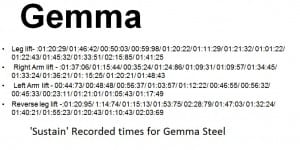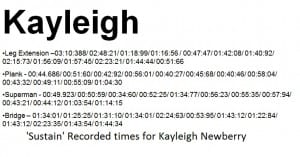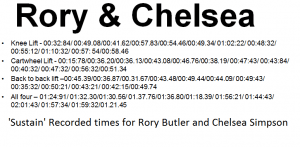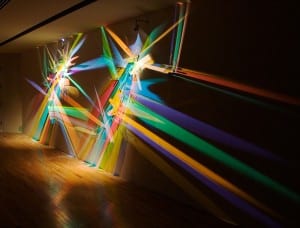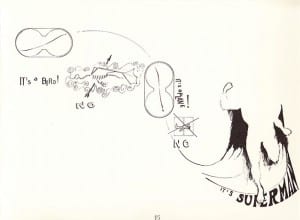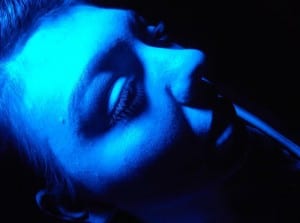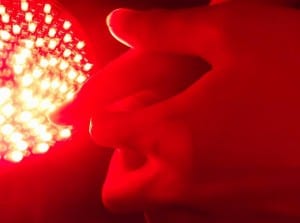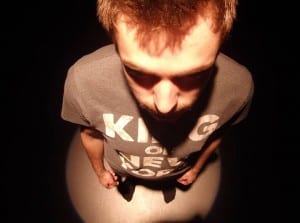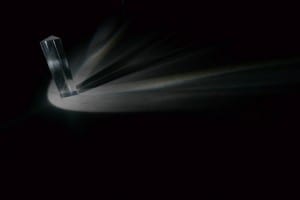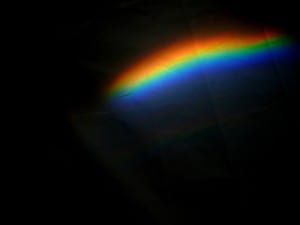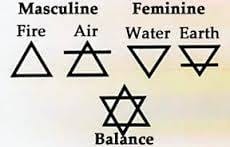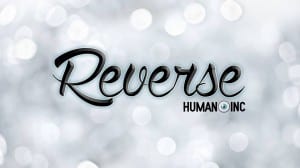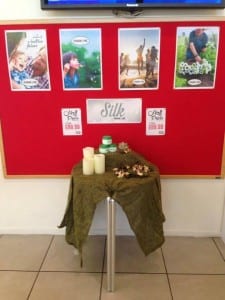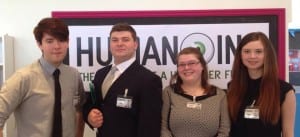Framing statement
Whilst taking part in the Site Specific module, my devising skills have developed and the process leading to the performance pushed my boundaries as a performer as well as the way I think of and look at performance.
My piece, Dispersion, was primarily based on light and sound paying particular attention to Isaac Newton’s discoveries. It was heavily influenced by the idea of performing in multiple spaces including an abandoned shop, the ‘Gravity Fields Festival’, and Lincoln Performing Arts Centre, eventually making the end product adaptable and versatile to be performed at more than one venue. The performance took place in studio 2 of Lincoln Performing Arts Centre on 10th May 2014. It began at 14:00 and ended at 18:00 with a thirty minute break which began at 16:00. This was a durational piece as we carried out tasks and experiments for thirty minutes at which point we rotated to the next task. Audience members were invited to enter and exit the space as they pleased with the freedom to explore the space and discover with us.
My initial research started with the basics of site and what this style of performance would ask of me. Richard Serra says of site-specific art; ‘To move the work is to destroy the work.’ (Kaye, 2000, 2) I would say that this is the same case for site-specific performance as once the piece is moved to a new site, it is ruined; the history, environment, location or social context of the site may have been a stimulus for the piece and therefore reflected in the work. As my piece relied heavily on science and having an understanding in something I had not studied since my time at secondary school, much of my research time went into rediscovering these theories.
Analysis of process
At the beginning of the devising process I originally thought that my final performance was going to be based in a vacant shop in Grantham with the theme of retail therapy. In order to get ideas flowing I spent lesson time, as well as time outside of university hours, observing customers and viewing shops, taking care to view the details of various shops and considering what my site might look like. For me, this was the most exciting part of the module as I had no idea what direction the performance would take.
The performance then started to take a different route to what I had originally thought. Although the site was still an abandoned shop in Grantham, we added an element of science to the performance rather than relating it to retail. This was because the final performance is going to be part of a festival held in Grantham called ‘Gravity Fields Festival’. The festival is ‘inspired by the work of Isaac Newton and includes ‘a dynamic and creative programme of science, arts and heritage events’ (Gravity Fields Festival, 2014). As the performance was being commissioned, we were sent a brief from the festival organisers including four different themes that each group would have to adopt; Gravity, alchemy, and two groups focused on light. I had decided that I wanted my final piece to involve the science behind sound and so it made sense to link this with the theme of light. Part of me saw the festival as a positive as it meant our piece had a starting point that we could develop. On the other hand I felt that this could have restricted us and our ideas that we already had due to the specific audience and nature of the festival.
I wanted to explore how others had already successfully explored light and sound in performance and in doing so, came across ‘The Light Show’ which took place between 30th January and 6th May 2013 at Hayward Gallery in London. The Light Show at the Hayward Gallery (UCLUPiTV (2013) Pi TV) Once piece that I found particularly interesting was ‘Cylinder’ by artist Leo Villareal whose work I decided to research further. These light installations, as shown in the video, made me question how different they would have looked with human interaction. How can these lights affect the human body? Could they make the body look deformed or broken? Would bodily interaction change the overall mood of the piece? These are all things I wanted to explore further and incorporate into the final performance.
Heavy science research lead me to find out Isaac Newton discovered that white light is not a single colour, but a combination of all the colours on the light spectrum. He backed up this theory by shining a white light into a prism; the light which came out the other end was multi-coloured, an experiment that had been completed before, making people believe that prisms were responsible for the colour change. Newton extended this experiment by using another prism which the multi-coloured light shone into. This time the light which exited the prism was white as the colours had refracted together, proving that the prism did not colour the light. ‘…Newton refracted sunlight with a prism into a colour spectrum – each coloured ray with a specific refrangibility, or angle of refraction. With a second prism, he demonstrated that each refracted ray of the colour spectrum is dispersed to the same degree as with the first prism.’ (Marcum, 2009, 458) Newton also went on to discover that light is made up of particles rather than just being a wave.
Our trip to Grantham helped us with the devising process, defining our ideas. On our initial visit to the site we were shown around possible performance spaces, several empty shops, luckily finding one which inspired us. I had imagined using mirrors during the performance to relate to refraction and the shop already had a variety of mirrors fitted around the space. This was a huge positive for us and we could instantly see our piece being performed in this space.
My group had discussed the idea of using a shop window as a way of grabbing the audience’s attention and at this particular shop this idea was possible as there was a ledge large enough to stand on and make us visible.
The shape of the room inspired us to have hidden parts of our performance, making the audience work to discover some parts of the piece. Finally, we also liked the variety of hooks and rails around the space which we could use to hang objects which related to our performance. We were not exactly sure of what these items would be, but we would figure that out further down the devising process.
As previously mentioned, site-specific performances are heavily influenced by the site, its history or the way it is currently used/set out; ‘Its usage, or former usage, may directly inform the dramatic structure’, (Pearson, 2010, 149) Although in my case, the inspiration was coming from the science festival and the work of Isaac Newton, there were still aspects of the shop’s past which were relevant to the theme. We were informed that Isaac Newton carried out many of his experiments in some of the shops in The George Shopping Centre, which is where the shop we had chosen was located.
During seminars, we had the opportunity to perform our work-in-progress to the rest of the class. To begin with, many of our ideas were inspired by physical theatre, especially the work of PUSH ‘Physical Theatre’, performances of STOMP and finally, John Bohannon, a biologist and science journalist. He delivered a talk called ‘modest proposal’ with help from a physical theatre company, Black Label Movement, to help explain his points in a more engaging way for the audience. This exciting explanation of science inspired us to explore and explain light through our bodies. To tie in sound to the performance we decided to create a soundscape with wooden spoons, playing various rhythms. The idea was to have sound waves projected on a wall, reacting to the sounds we made, showing the difference between high and low frequency sounds.
The pieces we were getting inspiration from were not necessarily associated with site performance. After realising this and getting similar feedback from our peers and lecturers, we decided to go back and study some site-specific practitioners for inspiration. Although what we had been devising was engaging, well suited to the festival audience and involved our theme of science, we came to understand that we were acting. ‘Rarely does site-specific performance focus solely upon, or proceed at the pace of, that form of dramatic dialogue in which characters talk face-to-face, exchange information and their feelings about things, and constantly refer to events off-stage, elsewhere, in the real world.’ (Pearson, 2010, 167) The whole point of site specific performance is to perform, not act. This can be done by completing tasks, reading aloud or simply just observing. It is crucial for us to understand that performance happens all of the time in everyday life before thinking about the performance itself. I think that we got carried away with our ideas and forgot this main principle and it resulted in an over complicated piece of theatre which was not completely obeying the rules of site specific performance.
I took a tremendous liking toward the company ‘Lone Twin’; their walks, journeys and durational performances. Their work consists of activities and tasks which heavily involve the audience. Many of their pieces have asked audiences to join them on a walk or help them to carry heavy objects. ‘The element of repetition or the extended duration of their activities also ask for the audience’s commitment; confronted with the impossibility of seeing the whole project the audience might make an effort to stay with them for a long time or to come back several times to witness the development of the project.’ (Willaims, 2011, 69) After reading about their work, I was inspired for my performance to become durational. I liked the idea of completing tasks and having no idea how long the audience would stay for.
It was then decided that we would go back to our original ideas of using certain materials such as prisms, microphones, projection and video in a simple way, completing science based tasks. The main focus of our piece was originally light and Newton’s discovery, therefore inspiring us to use prisms in the performance. To layer this we then brought in the idea of sound and the science behind it into the performance. Another way of layering the performance was our use of various elements of technology. ‘In a stratigraphic model of dramaturgy, site-specific performance is envisaged and executed as distinct strata or layers.’ (Pearson, 2010, 167) When showing sound we had the basic idea of projecting sound waves onto the wall showing how sound travels. We then added a microphone to the performance which interacted with the sound waves, showing the different dynamics and frequencies to the sounds we were making. The final part to this was to add text rather than unrelated noises. This was an original Newton text which described his discoveries whilst we attempted to show these around the space with the science based tasks. We also had an idea of taking photos on a Polaroid camera to capture moments of the performance and have them around the space for the audience to see. The more layers there are to a performance, the more the audience have to discover. Some audience members may relate to the projection whilst others may understand more from the text. This was to give the audience room to understand the piece in an inventive way without making it too obvious.
As many of our ideas started to drastically change, we decided to go back to basics and look at different lights and how they work. The light pictured below reacts to the sound around it; the colour of the light changes every time there is a loud sound. We thought this was a nice way to link light and sound together.
We spent two hours being creative with this light by playing the piano and seeing how often the colour changed, experimenting with the body and we also linked it to the sound waves which were projected on the wall.
The news was then broken to us that we would still be performing in the ‘Gravity Fields’ Festival in September but our performance in May would be taking place in the Lincoln Performing Arts Centre (LPAC). I think this can be seen as unfavourable due to the fact that we have planned out our performance to fit into the shop we visited in Grantham. However, there were many positives to this change as we could rehearse our piece in the site we will be performing in. We also did not have the issue of trying to get all of the technical equipment to the site as most of it was stored in LPAC. It was easy to assume because I was performing in a building where you would typically find tradition theatre performed, that it would take away the essentials of site-specific, however this was not the case; ‘Studio theatres are sometimes known as ‘laboratory theatres’ or ‘theatre workshops’ both of which suggest the process of experiment and ‘making’.’(Pickering and Woolgar, 2009, 26) Although our site changed, we decided to keep our performance the same meaning that our piece was not so much site specific but it could be known as site intensive or zone specific. For me, I think that our site was more metaphorical and could be known as the ‘Gravity Fields Festival’. We then adapted the piece so that our original site was in mind when devising as well as the new site, this made the piece highly versatile and could potentially be performed in many different spaces by only having a couple of changes to fit the space appropriately. This would entail; being able to black out a space, separate it into two rooms or sections and having the materials available as well as a power source. All of these changes which were made to our performance pushed us as a group in terms of being adaptable and open minded when things did not exactly go how they were originally planned.
Throughout these changes, I came to realise that the performance was no longer about explaining light and sound; it was more about what we had discovered and our journey throughout the devising process. This was shown by having a video of our devising and experimental process playing throughout the performance. We wanted the audience to feel as though they were seeing us experiment with light and sound in an installation setup, giving them the opportunity to walk freely around the space and enter and exit as they please; ‘Depending on where the spectators are positioned, they will see a different combination of performers and may thus interpret the situation differently.’ (Pearson, 2010, 176) By doing this, we hoped that each audience member would be present at varied points of the performance, meaning that us as performers and the audience would have discovered different things and had a varied experience.
Performance evaluation
As the set up for the piece was only small, I felt it was highly important to completely clear the space, sweep the floors and block out all light so that the audience would have the best experience possible. For the performance, the space was separated into two by a curtain. In the first half of the room two performers were experimenting with a prism, looking closely at how the light rays looked on the human body. Another performer was sat in front of a television watching the video we had created which involved more of our experiments with light. In the second half of the room, behind the curtain, the final performer was reading a piece of original Isaac Newton text. Reacting to the speech were sound waves which were projected onto a wall. The performer was lit by a light that changed colour, also reacting to the speech. Every thirty minutes, each performer moved in a clockwise direction to have their turn with the next task.
We had a steady flow of audience members; there were times when there was no audience present in the space but as we were completing tasks, the piece did not heavily rely on this. Some audiences walked in and out within a short space of time but others took the time to watch each task with care. Some sat with the performers and sat to watch the television which made it feel as though they were part of the task too. Many audience members were unsure on whether to go behind the curtain but all attendees eventually ventured to the second half of the space. After starting our performance we realised that, because the room was dark, it was not clear that anyone could enter at any time and therefore if performed again, some sort of sign would be helpful in securing this does not happen again. On the subject of performing this piece again, we actually have this opportunity in September during the ‘Gravity Fields Festival’. For this performance, we are going to meet up and make a few changes to the piece. I personally would love to try out our photograph idea. Whether this is with a Polaroid camera or by printing the pictures with an ordinary printer, I think it will be an effective way of capturing the beautiful moments of the prism on the body and another layer to the imagery already used in the video. We have also spoken about projecting the video rather than showing it and a television and making the video longer instead of having the short video on repeat. Another thing to think about when performing this in the festival is that the space is much different and will take a lot more time to block out the light and the number of audience members will increase dramatically.
Bibliography
Kaye, N. (2000) Site-specific art: performance, place and documentation. London and New York: Routledge.
Marcum, James A. (2009) The Nature of Light and Color: Goethe’s “Der Versuch als Vermittler” versus Newton’s Experimentum Crucis. Perspectives on Science, 17(4) 457-481.
Pearson, M. (2010) Site Specific Performance. Basingstoke: Palgrave Macmillan.
Pickering, K. and Woogar, M. (2009) Theatre Studies. Basingstoke: Palgrave Macmillan.
Williams, D., Lavery C. (eds) (2011) Good luck everybody: journeys, performances, conversations / Lone Twin. Aberystwyth: Performance Research Books
Woodhall, M. (2014) First visit to Grantham, Retail Therapy. [15th March]. Available from https://sitespecific2014dsy.blogs.lincoln.ac.uk/ [Accessed 12 MAY 2014]
Woodhall, M. (2014) Playing with lights, Retail Therapy. [3rd April]. Available from https://sitespecific2014dsy.blogs.lincoln.ac.uk/ [Accessed 12 MAY 2014]
The Light Show at the Hayward Gallery [online video] Available from https://www.youtube.com/watch?v=ot2NXm6EGuE [Accessed 15 May 2014]
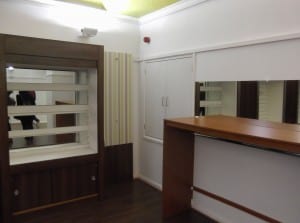
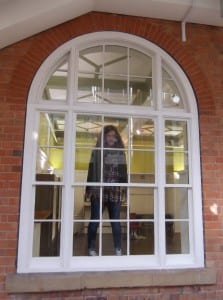
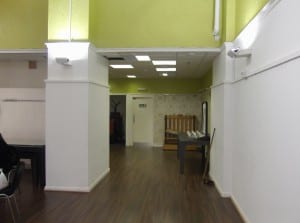
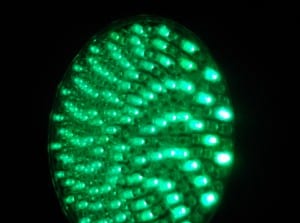

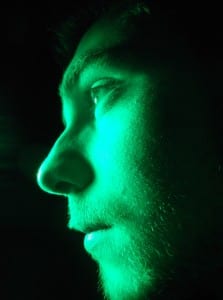


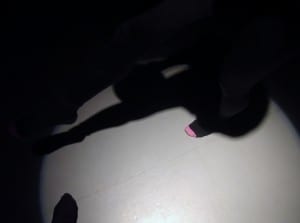
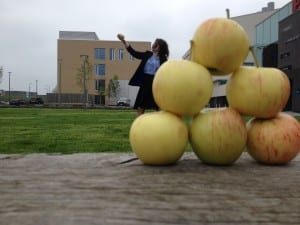 On May 10th 2014, Phil Munro, Kate Newman, Claudia Cross, Connor Mccue and I created our own piece of site specific theatre which was based or mostly influenced by the famous Isaac Newton when it was supposedly claimed that he theorised the notion of gravity immediately after an apple fell on his head from the tree. Our performance was based entirely on apples and we named it ‘101 things to do with an Apple’. Our first original title was to be The A team (which is a reference to the popular 80s TV show), but we decided to stick with the former as our title. At first, we wanted to recreate the entire Isaac newton story, laced with comedic and fictionalised acting. However, as we progressed more and more into our ideas, we instead decided to forget the acting and start doing. Many things we found to do with apples are mostly traditional and conventional things, but then wanted to steer off into the abstract and do thingsthat most people wouldn’t even dream of ever considering. It was a durational performance that evidently lasted around 4 to 5 hours with one break in between. The showing is to be the first of two as we are expected to perform at the Gravity Fields Festival in September. We was told that this festival was based around Newtonian science and we was to create something science based. We had a lot more freedom with the space at the Lincoln Performing Arts Centre, but I never really had the feeling that our performance was ‘site based’. We wanted to incorporate that feeling of decay and desolation into our piece. There was no talking throughout the entire performance as we felt that silence was a lot more authentic and related to the piece. We thought about audience participation from the start, but instead opted for audience reaction. I will discuss how our process went from trying to ‘act’ out our performance in the early stage, to creating a piece of art that enables one to go deeper within the boundaries of theatre as a whole.
On May 10th 2014, Phil Munro, Kate Newman, Claudia Cross, Connor Mccue and I created our own piece of site specific theatre which was based or mostly influenced by the famous Isaac Newton when it was supposedly claimed that he theorised the notion of gravity immediately after an apple fell on his head from the tree. Our performance was based entirely on apples and we named it ‘101 things to do with an Apple’. Our first original title was to be The A team (which is a reference to the popular 80s TV show), but we decided to stick with the former as our title. At first, we wanted to recreate the entire Isaac newton story, laced with comedic and fictionalised acting. However, as we progressed more and more into our ideas, we instead decided to forget the acting and start doing. Many things we found to do with apples are mostly traditional and conventional things, but then wanted to steer off into the abstract and do thingsthat most people wouldn’t even dream of ever considering. It was a durational performance that evidently lasted around 4 to 5 hours with one break in between. The showing is to be the first of two as we are expected to perform at the Gravity Fields Festival in September. We was told that this festival was based around Newtonian science and we was to create something science based. We had a lot more freedom with the space at the Lincoln Performing Arts Centre, but I never really had the feeling that our performance was ‘site based’. We wanted to incorporate that feeling of decay and desolation into our piece. There was no talking throughout the entire performance as we felt that silence was a lot more authentic and related to the piece. We thought about audience participation from the start, but instead opted for audience reaction. I will discuss how our process went from trying to ‘act’ out our performance in the early stage, to creating a piece of art that enables one to go deeper within the boundaries of theatre as a whole.
